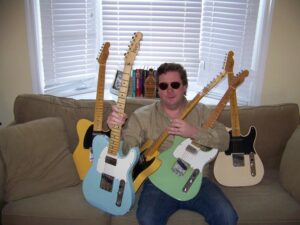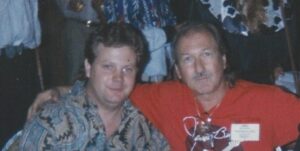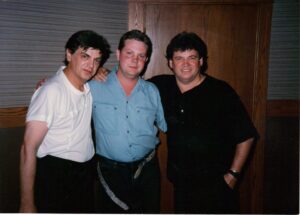Whether you were born and bred in the Bluegrass or are a transplant, chances are good to great that you know Lexington has a rich artistic heritage. This is especially true with respect to music. Some of the greatest pickers and grinners of all time have come from Fayette County and the areas surrounding it.
Patrick Golden is one such artist.

Born in Lexington, July 14, 1966, Pat recently celebrated over 40 years in music and has influenced hundreds of students and peers. Known worldwide for his ‘chicken-pickin’ style, Golden is an accomplished guitarist, transcending genre with a style recalling many great players, but most definitely all his own.
Before we chat with Pat and a host of guitar greats who have performed and studied with him, how about a listen? Here’s a clip of Golden promoting Knight Guitars. He is playing a signature Richard Young edition, customized for the Kentucky Headhunters’ rhythm guitarist and vocalist.
The Headhunters still tour a great deal and have had a string of hits over the last 25 years. Headhunters’ lead guitarist Greg Martin has been friends with Golden for some time.
How did you and Pat hook up?
Pat was freelancing with my stepdaughter, Sherri McGee who is in Little Miss Tammy Smith and the Inbreds. That’s how I got to know him. He reached out to me years ago. He’s great about being open to learning new things.

What is most striking to you about his playing style and approach to teaching?
Pat’s a very dedicated player, a very patient player, and a great teacher. Stylistically, he has his own take on the Tele “twang†thang for one thing, but there is much more to his playing. He loves Telecaster and he’s really creative with its use.
Here’s a clip of the Pat and Greg working some magic.  And here he is, jammin’ with Headhunters’ drummer, Fred Young.
In this exclusive conversation for UnderMain, Golden talks about his playing, his teaching, and growing up in the Bluegrass.
Why electric guitar?
“It all started acoustic,†he explains. “My step-dad gave me an old Craftsman Acoustic back in 1973. It was the f-hole style guitar and it wasn’t much, but it got me started. I banged around on that old thing for a few years. My mother and grandmother wanted to see if I was serious and would stick with it before they bought me an electric, which is what I really wanted.â€
Soon after, Pat got his first electric guitar, an old Sears and Roebuck model.
Was it just getting that electric guitar that set you on your path, or something else?
“My mother took me to an Elvis concert in 1976 in Cincinnati; this was just a year or two before he died, and it changed everything for me. It felt like I was supposed to be there. I could tell you what the weather was like and what we had for lunch. It was the most intense experience of my life up to that point and a day doesn’t go by that I don’t think about it.â€
It wasn’t just the King’s charisma that captured Golden, however.
“It was James Burton. James Burton was and is my biggest influence. I saw him originally playing with Elvis and I became absorbed by his style and professional manner. He could cross into any genre and he has many times, playing with Merle Haggard, with Elvis Costello, John Denver, Johnny Cash, the list goes on and on.â€

It was also Burton’s influence that led Golden to play a particular type of electric guitar: the Fender Telecaster, or “Tele†for short.
What is it about the Telecaster that made sense to you?
“My first good quality electric was a Gibson Les Paul. I just found playing very limiting for what I was trying to do. The Tele offers me a much wider range of options. I can do more of the things I really want to do with a Tele. Stratocasters, Les Paul, they’re all great, but the Tele is right for me.â€
What happened after the Burton experience?
“I started to absorb everything I could to be versatile like Burton: Django Reinhardt, Johnny Cash, Jerry Lee Lewis. I’d watch all the great acts on Burt Sugarman’s Midnight Express in the 70s; Hee Haw, which, of course, had Roy Clark, Buck Owens, and Don Rich. Right after watching something that was Country, Rock, or Blues, I’d switch over and take in Lawrence Welk. All of these things and more were influences. In those days there were just three channels and no internet, so you watched what came on, and I watched intently, with the idea of applying it to playing.â€

You’ve taught Blues, Funk, Rock, Country, Jazz and many other genres, but you seem to have a lot of Country influence. How did that come about?
“Well, in the 70s in Lexington, you would have bands playing in local bars 6-7 nights a week. Most of the stuff being played was Country. I was a teen and wanted to play, so that’s where I landed, but I’ve always been interested in and played everything.â€
When did your playing first get some real notice?
“Many years ago WKQQ had a contest for the best young rock guitarist and I submitted a demo, which, of course, at that time was on a cassette tape. There were a lot of people entering. Ben Lacy was in the mix, and a lot of other amazing guitarists. Neither of us won, but it did give me more exposure.â€
Ben Lacy’s been on the Lexington music scene as a highly refined guitarist for many years. Lacy said the following recently of Pat’s playing:
“He is the purest of tele pickers, able to capture the essence and truly honor the personality of the Tele from classic country sounds and the blues. You can hear all that glorious pedigree of such greats as Danny Gatton and Scotty Anderson but still you can hear Pat’s own voice on the instrument. I’m proud to know Pat and admire his ability to not only perpetuate the rich tradition of the telecaster but also to forge his own path.â€

But was this what got Pat to Nashville and becoming a sought-after sessions player?
“It helped, but late in the 80s I met Bobby Anderson, who was then a writer for Hee Haw. Bobby was from Somerset and we went down to Nashville together, and he connected me to the staff at The Grand Ol’ Opry; Jim Ed Brown, who had a show for many years and many well-known artists. Most of them would hang out at the Nashville Palace. If you’re a sessions-player, singer, songwriter, or anything else musical in Nashville, the Palace is the place to be.â€
What happened when you got deeper into the Nashville scene?
“The same thing that happens to all players who go there: a reality check. I thought I was a great player, but I didn’t know what that was until I got to Nashville, and there’s one on every corner. I remember going to a show and being sick in the parking lot after, realizing what I was up against.â€

Where did you go from there?
“Well, I had a decision to make. Either tuck my tail and go home, which is what happens to so many players, or buckle down and get focused.â€
You chose the latter, but how exactly did it manifest?
“I went looking for the best people I could find to study with and learn. The first teacher I sought out was Ray Flacke. He was known at the time as being one of the best country pickers and had recorded with everybody.â€
Some of those artists include Ricky Scaggs, Travis Tritt, Marty Stuart, Kathy Mattea, and Emmylou Harris. The English-born Flacke has been known for four decades as one of the greatest country Tele-pickers in the industry. He is also well-known as an instructor and sessions player.

Golden continues:
“Someone who continues to influence me greatly is Scotty Anderson. I still drive up to Ohio and study with Scotty; he’s in the top .01 percent of players in the world, but he’s kept a low-profile for many years. Any serious player knows about Scotty, though; he’s in a realm all his own. I’ve been with him over twenty years now and I’m still working on that first lesson.â€
Here’s what Anderson has to say about his long-time student and friend, Pat Golden:
“Throughout the years I’ve seen Patrick turn into a fantastic player. He was always a really good player, but now he’s reached the level of commercial music greatness really, really unique in his own style. Maybe I was able to help him a little bit; I definitely could tell his playing in a room full of players. He always plays the right notes at the right time and he’s a hell of a nice guy.â€
These sentiments about Golden echo throughout the industry, not just with his instructor of many years.
Cartersville, Kentucky singer/songwriter, Josh Logan, has been friends with Golden since the 80s. Logan recorded four albums for the world-renowned Curb Records, starting in 1988. Somebody Paints the Wall included three chart singles which have been covered by artists like Tracy Lawrence and Aaron Tippin.
You and Golden go back a long way?
“Oh, yes. My friend Pat: I can’t say enough good things about him. He’s one of finest real country guitar pickers that I have ever met, his style is the real deal, not computer automated!”
On your tours, did you ever use Pat?”
“The sad part of my story is that I never had him as my lead guitar picker. The timing was always wrong for him to join my band, when I was on the road heavy in the 80s and 90s and early 2000. However, he’s a real country guitar picker, and with his ability to play just about anything that you need on a guitar, I’m sure he could just about fit any style that you need.
Golden’s influence crosses genres and spills out of the Country music scene as well. Blair Carmen, who tours with his band, Blair Carmen and The Belleview Boys, hails from Cincinnati, Ohio. The band stays with a lot of Jerry Lee Lewis and Big Band-style songs. Carmen commented on Pat’s playing and professionalism.
“In 2010, I contacted Patrick about an audition to see about him filling in on some road dates with my band. Since we were doing a mix of retro Honky Tonk Rockabilly Piano Pumpin’ Rock & Roll type stuff, I needed someone who was pretty versatile, yet still hardcore at the old country and rock & roll styles. First chance I had, we went down and met him at his home for an audition, which ended up only lasting five minutes. He introduced himself as a no-nonsense, hardcore honky Tonkin’ chicken pickin’ Telecaster picker…and that he was! I looked around, saw many of his different telecasters and vintage Fender amps and knew I was in the right place. He strapped on his 50s Tele and fired into Merle Haggard’s The Bottle Let Me Down and I said ‘Whoa now, we don’t even do that song, but maybe we will now!’  Then he played a little of Workin’ Man Blues and a bit of a rock & roll tune called Big Hunk a Love and I said ‘When can ya start ?’ He asked, ‘When do ya need me?’ And I said: ‘tomorrow.’ It’s been a blast ever since.â€
So how did the rehearsals play out?
“Patrick joined us on the road immediately with no practice, no rehearsal, no set list, and no keys to any song and he hung right in and honky tonk’d and rock’d & roll’d like we’d been playing together for years. We played throughout Indiana, Kentucky, Ohio and Washington, DC, at a huge swing dance in the Spanish Ballroom at Glen Echo Park, and outside Atlanta, Georgia, where special guests, J.W. Brown, Rusty Brown, and Jerry Lee Lewis’ ex wife/2nd cousin (13 year old child bride) Myra Gale joined us.  J.W. Brown was Jerry Lee Lewis’ original bass player in the 50s and 60s and played on all of his hit records. J.W. Brown got up and played a few songs with us. He was really impressed with Patrick’s playing and even told me after the show, ‘Now that there’s a guitar picker!’ That’s what we musicians love to hear!â€
So, are you still get together?
“Oh, yeah. Patrick still fills in often with us and is always very professional. He’s always early and on time. He’s also very picky about and always has great tone! Very reliable and great personality, too. That means a lot when you have to work and travel with someone.

Rick “LD†Wayne, the lead guitarist for Randy Travis, concurs. A good friend a Pat’s for the last twenty years, Wayne has toured and recorded with Tom T. Hall, Waylon Jennings, Porter Wagoner, and many others, in addition to the Travis albums.
What’s the story with you and Pat?
“I met Pat many years ago when I was working at the Nashville Palace, and he came in with Bobby Anderson, who worked on the Hee Haw staff. We started talking about Telecasters and realized we both had a passion for them. He’s a wonderful player. He’s always learning something and showing me something. He comes and plays with me all the time. He’s a wonderful friend.â€
Wayne’s is a Cinderella story, heading to Nashville from Columbus, GA when he was 18 with his guitar strapped to his back. He immediately got a job with Tom T. Hall, then with Johnny Rodriguez. After being at the Nashville Palace for about three years, he met Randy Ray, who became Randy Travis. Randy became a star and Wayne started toured and recorded with him until 2013, when Travis had a stroke and had to slow down.
What is it that makes Pat’s playing so special?
“Pat has mastered the Telecaster. He knows what pickup to use in the front, back, and middle positions. He’s learned how to play between these for particular songs. He is one of the most efficient players I have ever seen. I deeply respect him personally. No one’s better than Patrick at getting the most out of a Tele. He puts a lot of heart and soul in it and I respect his playing immensely. He’s a great player and teacher.â€
Wayne says he and Golden have spent many hours learning from each other.
“I’ll say ‘what did you do there, show me that!’ I’ve learned a lot from him. He’s showed me stuff he’s learned from others like Clint Strong; he just has so much skill and a lot of soul. I’ll usually send potential students his way, if they’re up near Kentucky. The thing about Pat, he’s very humble and doesn’t talk himself up a lot the way a lot of people do in this industry. You can’t help but respect his playing, but his humbleness makes me respect him as a person.â€
It was in the mid-90s when many years of playing and teaching paid off for Golden. He got the call to tour with Jerry Lee Lewis and play alongside Lewis’ longtime guitarist, Kenny Lovelace.

Touring with Lewis taught him a lot and when Golden returned to Kentucky, he focused on teaching and running to sessions in Nashville, Austin, and a handful of other music meccas in America. Many of his lessons are taught through Skype these days as well as his home, with students from all over the world.
What do you like about teaching, Pat?
“It’s so important as a teacher to be able to transcend genre, relate to the student, and ultimately give students what they come to you to learn. I usually just ask students where they want to go with their playing and take them on that journey. Doing it this way, you’re always giving the student what they want, which keeps them interested and makes the process fun.â€
NOTE: Pat Golden can be reached at (859)221-4633 or (859)271-8812. His email address is hottelepicker@yahoo.com. Pat is also on Facebook and can be messaged there as well.
Photos courtesy of Patrick Golden




